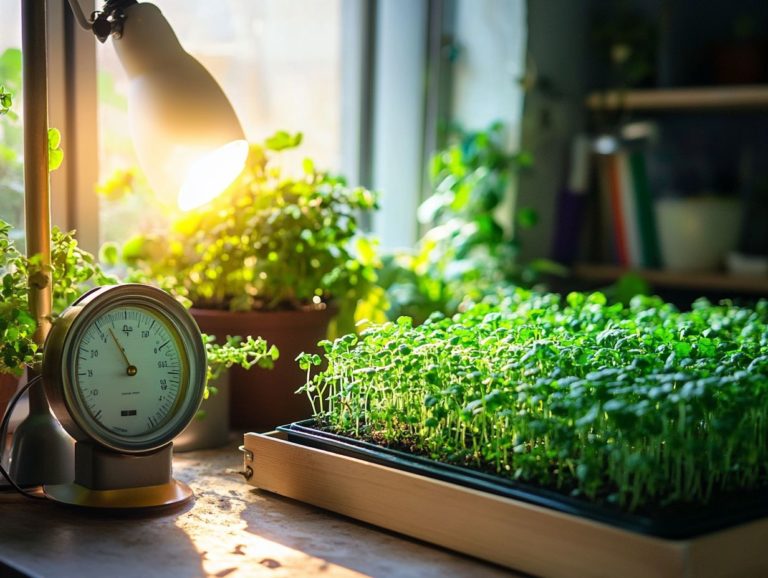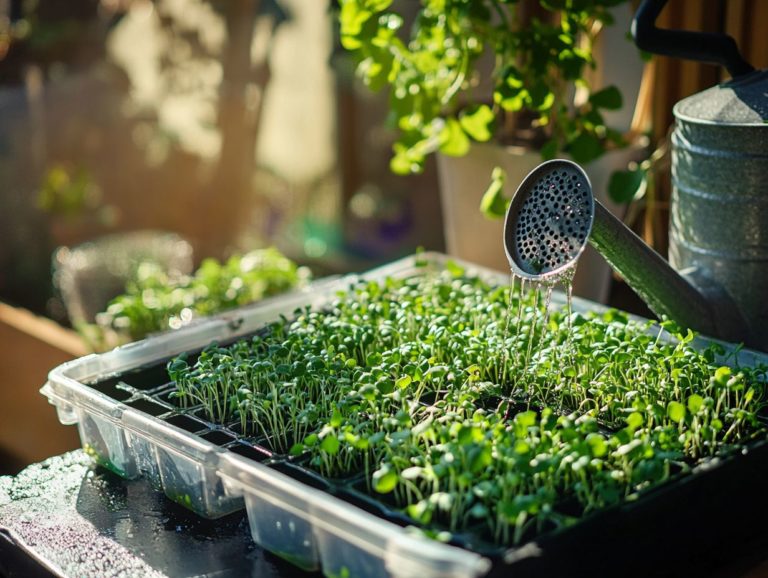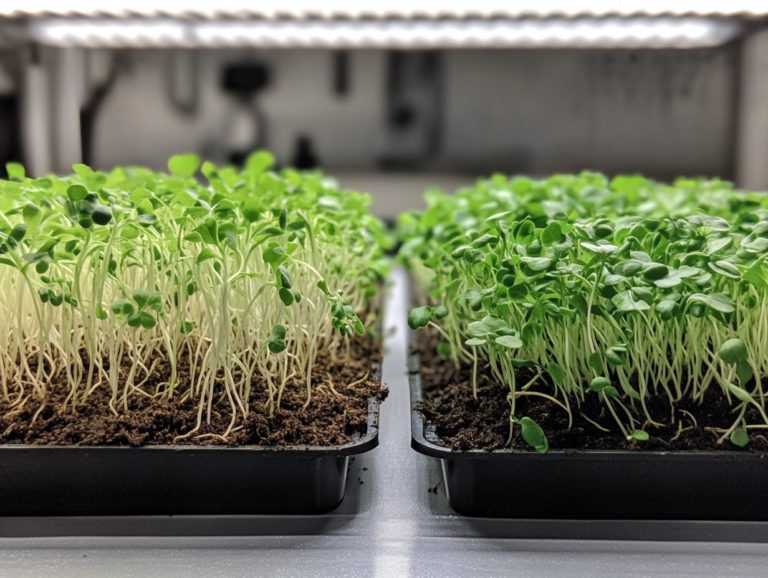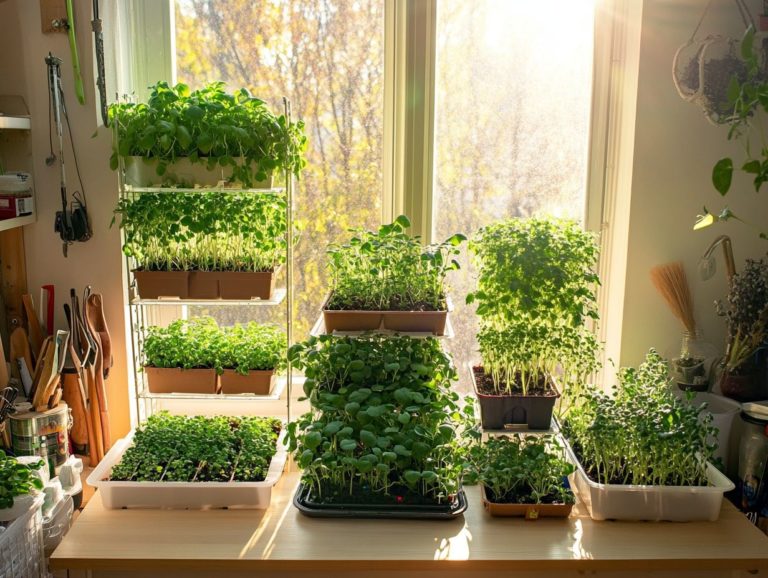How to Use Hydroponics for Microgreens
Hydroponics is revolutionizing your approach to food cultivation, presenting a soil-free method that optimizes both space and resources.
This article delves into hydroponics specifically for growing microgreens. You’ll uncover the advantages of this innovative technique, learn how to establish your very own hydroponic system, and discover which microgreens flourish best in these conditions.
From the initial setup to the moment of harvesting, this guide is your roadmap to a thriving hydroponic garden!
Dive in now and enjoy the incredible benefits of fresh, homegrown microgreens!
Contents
- Key Takeaways:
- Setting Up a Hydroponic System for Microgreens
- Growing Microgreens in a Hydroponic System
- Harvesting and Using Hydroponic Microgreens
- Frequently Asked Questions
- What is hydroponics and how does it work for growing microgreens?
- What equipment do I need to use hydroponics for growing microgreens?
- How do I set up a hydroponic system for growing microgreens?
- What types of microgreens grow best in hydroponic systems?
- How often should I change the nutrient solution in my hydroponic system?
- What are the benefits of using hydroponics for growing microgreens?
Key Takeaways:
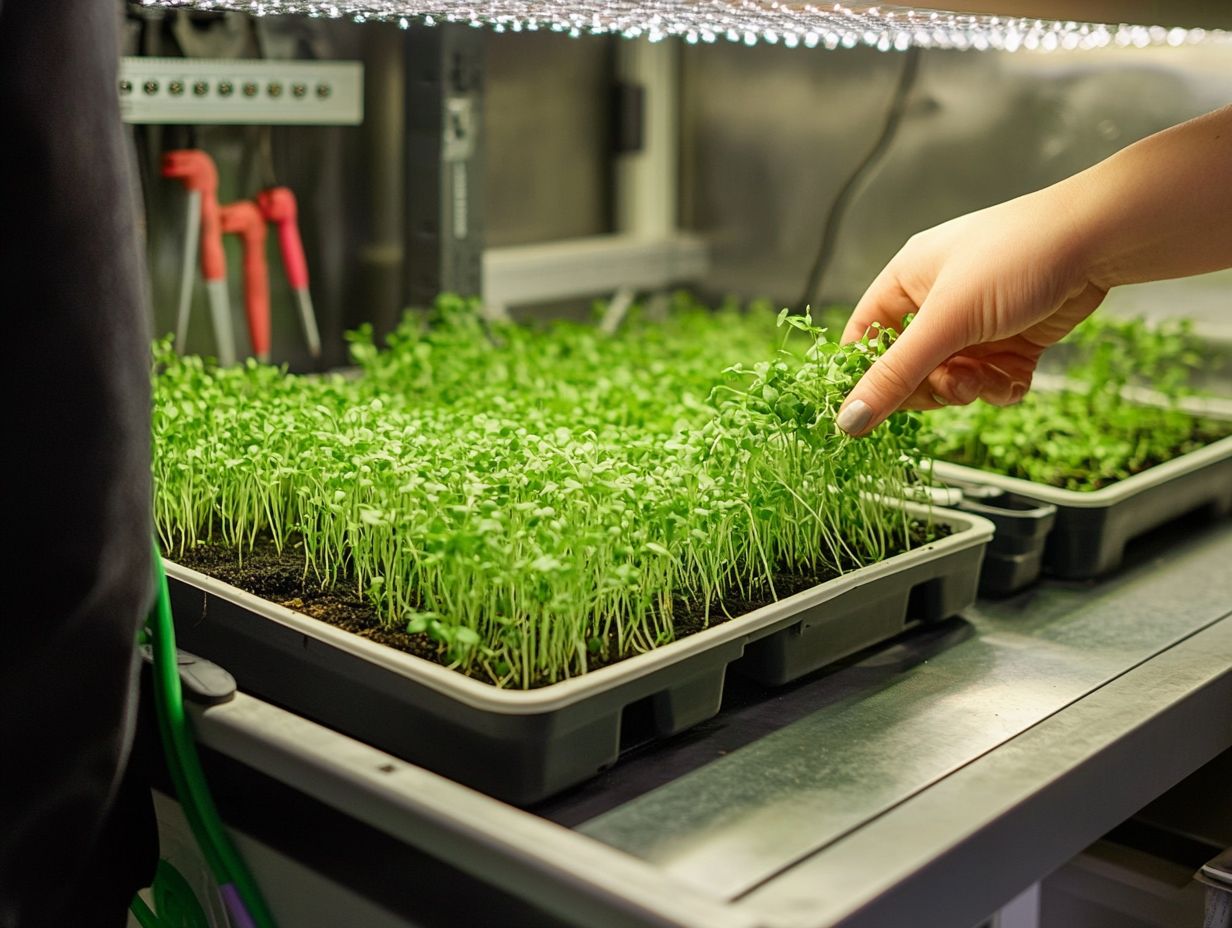
- Hydroponics is a method of growing plants without soil, using a water-based nutrient solution instead.
- Hydroponics is ideal for growing microgreens due to their quick growth and high nutrient density.
- Setting up a hydroponic system for microgreens requires specific materials and equipment, and maintaining optimal growing conditions is crucial for successful growth.
What is Hydroponics?
Hydroponics is an innovative gardening method that allows you to grow plants without soil, relying instead on nutrient-rich solutions that deliver essential minerals directly to the roots.
This approach revolutionizes traditional gardening by eliminating the need for soil, which often harbors pests and diseases. You can use various mediums like coconut coir, celebrated for its moisture retention. Alternatively, perlite excels in aeration and drainage.
Managing pH levels is vital in hydroponics. Even the slightest fluctuations can impact nutrient absorption, making careful monitoring essential to your success.
Hydroponic systems like nutrient film technique (NFT), where a thin film of nutrient solution flows over plant roots, and deep water culture (DWC), where roots are submerged in nutrient solution, cater to different plant types and growth stages, enhancing your gardening versatility.
With these practices, you can grow fresh produce year-round, taking full advantage of shorter growth cycles and higher yields.
Why Use Hydroponics for Microgreens?
Utilizing hydroponics for growing microgreens presents you with a wealth of benefits, including accelerated growth rates and enhanced nutritional content that surpasses that of soil-grown varieties.
Hydroponic methods allow you to maximize space efficiently, making it the perfect choice for countertop gardening.
By employing appropriate growing mediums like hemp mats or coconut coir, you can ensure optimal water retention. This technique fosters quicker germination and minimizes the risk of root diseases, ultimately leading to a bountiful harvest of baby salad greens that are bursting with flavor and nutrition.
These systems give you the power to meticulously control environmental conditions, further speeding up growth cycles. With reduced exposure to pests and pathogens, the need for chemical interventions is significantly curtailed, promoting a healthier harvest.
Hydroponically grown microgreens are typically cultivated in a more sustainable manner, using considerably less water than traditional gardening methods, aligning with contemporary environmental goals.
Ultimately, this innovative approach helps city dwellers like you grow fresh food year-round, regardless of climate or spatial limitations.
Setting Up a Hydroponic System for Microgreens
Setting up a hydroponic system for microgreens requires careful selection of the right equipment and materials to create optimal growth conditions. You’ll need growing trays, a nutrient solution, and a method for effective air circulation.
This setup grants you precise control over the environment, enabling you to easily manage key factors such as light source, temperature, and humidity.
By adhering to specific planting instructions and utilizing materials like growing mats or pads, you can transform any space into a productive haven for growing various microgreens, reaping the numerous nutritional benefits they provide.
Required Materials and Equipment
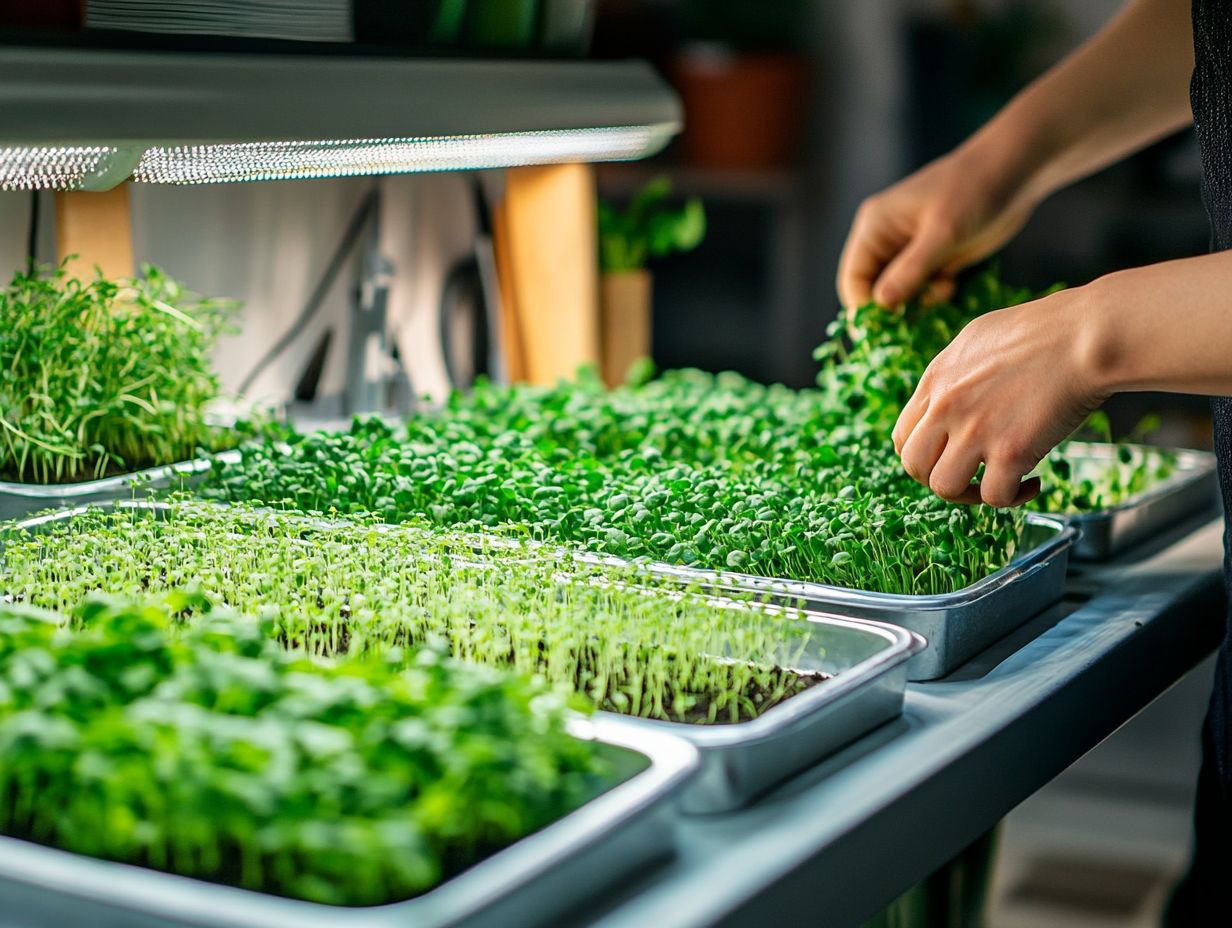
To successfully establish your hydroponic system for microgreens, you need essential materials and equipment. Start with a suitable growing medium, such as coconut coir or hemp mats, which provide a solid foundation.
Adequate LED grow lights are crucial for optimal photosynthesis. Growing trays support the plants during their various growth stages. A balanced nutrient solution delivers the necessary minerals, and don’t overlook water quality. Maintaining proper pH levels ensures effective seed germination. The right tools simplify the process and enhance crop growth and overall yield.
Using high-quality organic seeds tailored for hydroponics can significantly impact the health and flavor of your microgreens. For a detailed approach, refer to our step-by-step guide to sowing microgreens. Choose a growing medium that retains moisture while providing good aeration, as this directly influences root development and nutrient uptake.
Different mediums, like rock wool or perlite, each offer unique advantages for specific microgreen varieties. pH test strips are critical for maintaining optimal acidity levels, which are essential for effective nutrient absorption.
Keep a close eye on your hydroponic setup for vibrant, robust crops! Regular monitoring is key to ensuring balance.
Step-by-Step Setup Guide
Creating an effective hydroponic system for microgreens requires a systematic approach, including precise planting instructions, a well-defined watering schedule, and a nutrient-rich solution for optimal crop management.
To begin, select high-quality organic seeds. Prepare your growing trays by adding the chosen growing medium with excellent water retention capabilities. Mist the seeds during germination to enhance sprouting and cultivate an ideal microenvironment. For advanced methods, learn how to use hydroponics for microgreens. Monitor moisture levels closely to avoid the pitfalls of over or under-watering.
After germination, establish a watering schedule to hydrate the seedlings every 2-3 days, ensuring they absorb nutrients consistently. Regular maintenance of your nutrient solution is vital; check the pH levels to keep them in the sweet spot of 5.5 to 6.5.
Lastly, maintaining optimal environmental conditions such as using grow lights for about 12-16 hours a day and ensuring adequate air circulation will further promote healthy growth and lead to a bountiful harvest.
Growing Microgreens in a Hydroponic System
Growing microgreens in a hydroponic system is an artful blend of innovative techniques and meticulous management. This method maximizes both yield and flavor. It all starts at the germination stage, where elements such as light source, water quality, and environmental conditions are vital for ensuring optimal seed growth.
Avoid common pitfalls, like planting too densely, which can create competition and stunt growth. This attention to detail leads to robust, flavor-packed harvests that are extraordinary.
Best Microgreens for Hydroponic Growth
Several microgreens thrive exceptionally well in hydroponic systems, making them ideal choices for beginners and experienced growers alike. Varieties such as arugula, broccoli, cilantro, and radish not only offer ease of cultivation but also deliver a delightful punch of flavor and nutrition. These nutrient-dense baby salad greens are celebrated for their rapid growth cycles, allowing for quick harvesting and consumption perfect for hydroponics.
Among the top contenders for hydroponic cultivation, basil stands out with its aromatic leaves that elevate dishes and are packed with essential vitamins. Meanwhile, sunflower shoots are known for their robust crunch and impressive protein content. Each variety has its own care requirements; for instance, cilantro thrives in cooler temperatures, while basil prefers a warmer environment to maximize its aromatic oils. Understanding the science behind microgreen growth can also enhance your cultivation techniques.
By understanding these growth characteristics and providing the right conditions, you can optimize flavor and yield, transforming your hydroponic garden into a thriving oasis of health.
Optimal Growing Conditions and Maintenance
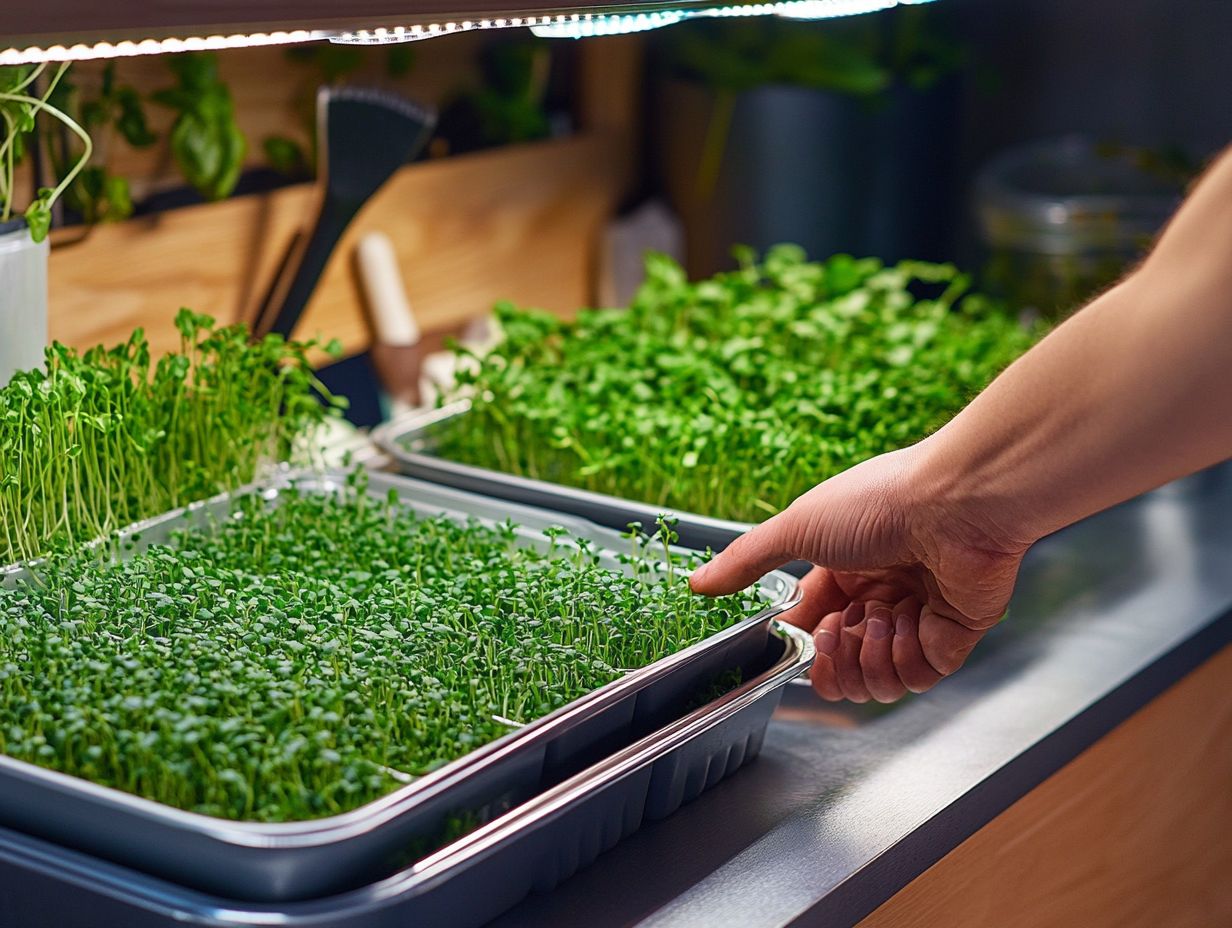
Maintaining optimal growing conditions is vital for the success of your hydroponically grown microgreens. Focus on key factors like keeping the right moisture level, nutrient solution quality, and environmental conditions. Effective air circulation helps prevent mold growth. A consistent watering schedule ensures your plants receive just the right amount of hydration. This prevents over-watering and under-watering.
By regularly monitoring and adjusting these variables, you can cultivate an ideal environment that promotes healthy crop growth and maximizes your yield. Temperature is another crucial factor; aiming for 65 to 75 F is ideal for most microgreens. Keeping the humidity level between 40-60% can significantly enhance seedling development, especially when using techniques for growing microgreens year-round.
Proper lighting is also essential. Aim for 12-16 hours of bright, indirect light each day to encourage robust growth and prevent your plants from becoming leggy. If you find yourself in an area with limited natural sunlight, using grow lights can be a game-changer.
Check nutrient levels regularly and adjust them according to your microgreens growth stage. Use a nutrient solution that is pH balanced, meaning it has the right acidity level to support plant growth. This attention to detail will support sustained development, allowing you to reap the rewards of an abundant harvest.
Harvesting and Using Hydroponic Microgreens
Harvesting hydroponic microgreens at the optimal moment is essential for savoring their full flavor and reaping their nutritional rewards, especially if you’re using organic seeds. These petite greens are celebrated for their remarkable nutrient density and vibrant taste.
When the seedlings showcase their first true leaves, typically within 7 to 21 days, it s time to take action. Timing your harvest just right guarantees maximum flavor and vitality, especially if you choose to leave some for transplanting into larger systems.
When and How to Harvest Microgreens
Identifying the perfect moment to harvest microgreens is crucial for capturing their peak flavor and nutritional benefits. This typically occurs just after the germination process when true leaves make their debut.
At this stage, these tiny greens burst with vibrant colors and bold flavors, making them a favorite among culinary enthusiasts and health-conscious individuals alike, especially baby salad greens. Most varieties are ready for harvesting when they reach about 1 to 3 inches in height.
For an effective harvest, use sharp scissors or a knife, cutting just above the growing medium to minimize root damage and encourage future regrowth. After harvesting, gently rinse off any soil residues, thoroughly dry them to prevent moisture buildup, and store them in clean, damp towels.
Paying close attention can truly boost the freshness and shelf life of your hydroponic microgreens, making them an excellent addition to salads, garnishes, and an array of dishes. Utilizing proper watering techniques for thriving microgreens is key to achieving optimal results.
Ideas for Using Harvested Microgreens
Harvested microgreens can elevate your culinary creations, infusing them with delightful flavors and a remarkable nutrition boost. Their dense nutrient profile opens up a world of creative possibilities, whether you re tossing them into salads, layering them in sandwiches, or using them as elegant garnishes for soups and main courses.
Incorporating these tiny greens into your recipes enhances both the visual appeal and the flavor, making them a superb addition to any meal, particularly when using growing trays for indoor gardening.
Imagine transforming a boring salad into a vibrant dish by tossing a handful of peppery arugula microgreens into a simple vinaigrette. You can also layer them between slices of whole grain bread with spreads like avocado or hummus, effortlessly elevating a mundane sandwich into a gourmet experience. Here, water retention becomes important as well.
In pasta dishes, adding basil microgreens just before serving brightens the plate and imparts an intense burst of flavor.
Nutritionally, these greens are a powerhouse, packed with vitamins A, C, E, and K. They offer beneficial antioxidants that support overall health. By utilizing hydroponically grown microgreens, you can explore exciting new flavor profiles while reaping their health benefits.
Frequently Asked Questions

What is hydroponics and how does it work for growing microgreens?
Hydroponics is a method of growing plants without soil, using a nutrient-rich water solution. This technique allows for better control over plant growth and results in faster growth and higher yields for microgreens.
What equipment do I need to use hydroponics for growing microgreens?
Wondering what equipment you need? You will need a growing container, a water reservoir, a pump, grow mats or growing pads, LED grow lights, and a nutrient solution. You may also need pH test strips and a timer for optimal results.
How do I set up a hydroponic system for growing microgreens?
First, choose a suitable growing container and fill it with your chosen growing medium, such as vermiculite or perlite. Place the water reservoir below the growing container and connect them with a pump and tubing. Set up your grow lights and mix your nutrient solution according to the instructions. Finally, place your microgreen seeds in the growing medium and turn on the pump to start the hydroponic system.
What types of microgreens grow best in hydroponic systems?
Many types of microgreens thrive in hydroponic systems, including kale, radish, broccoli, and sunflower. Choose microgreens with similar growth rates and nutrient requirements to ensure a bountiful harvest, such as cilantro, arugula, and radish.
How often should I change the nutrient solution in my hydroponic system?
The frequency of changing the nutrient solution depends on the size of your hydroponic system and the type of plants you are growing. As a general rule, it is recommended to change the solution every 1-2 weeks to prevent nutrient deficiencies and maintain optimal growth, ensuring effective moisture control.
What are the benefits of using hydroponics for growing microgreens?
Hydroponics offers several benefits for growing microgreens, including faster growth, higher yields, and better control over plant growth. It eliminates the need for soil, making it a cleaner and more efficient method. Hydroponics allows for year-round growing, regardless of weather conditions, making it ideal for countertop gardening or indoor gardening.

